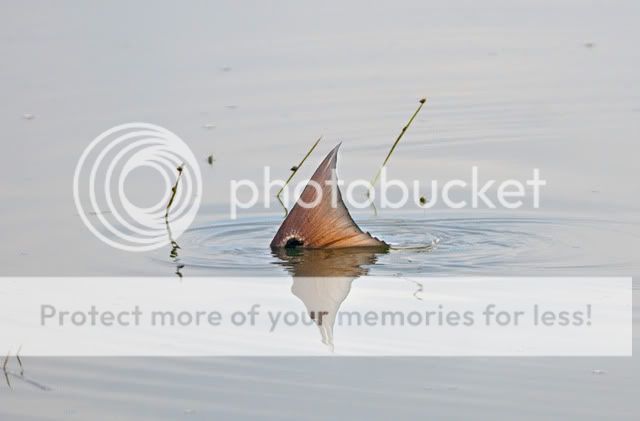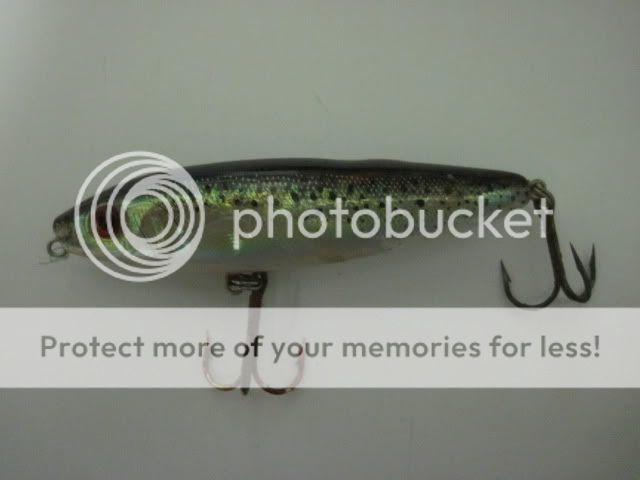 As an angler, there is probably no bigger thrill than seeing your quarry, stalking it, making a presentation, and watching the fish attack your bait. A tailing redfish may be one of the most exciting guarantees in the arena of sight fishing. Once that fish stands on his head to root out a meal, he literally becomes stupid. Harsh words I know, but at that moment, any well placed bait put in front of him will almost certainly be inhaled. Those tails are up there for ONE reason only--and that is to EAT. That being said, where do we find said ignorant tailing redfish?
As an angler, there is probably no bigger thrill than seeing your quarry, stalking it, making a presentation, and watching the fish attack your bait. A tailing redfish may be one of the most exciting guarantees in the arena of sight fishing. Once that fish stands on his head to root out a meal, he literally becomes stupid. Harsh words I know, but at that moment, any well placed bait put in front of him will almost certainly be inhaled. Those tails are up there for ONE reason only--and that is to EAT. That being said, where do we find said ignorant tailing redfish? The first thing involved in “what and where” is to identify spartina grass. One of the easiest ways to spot this type of marsh grass is height and coloration. Spartina grass will often be slightly lighter in color and shorter than the tall lush green marsh grasses. Often these grass flats are actually tan, gold or brown in coloration. On higher ends of the tides where you can see above the marsh line, these patches often looked “mowed”. These patches may be as small as a baseball diamond, or may extend for acres at a time, and can be accessed many different ways. Generally, the edge will border a spot that you can anchor your boat up to close enough to step out. The tall thicker green marsh grass is what you will avoid, as the bottom will be soft. The method and timing of this type of fishing will eliminate any chance of getting stuck high and dry (more on this in the “when” section). One of the best views of these spartina flats are along the Jekyll and St. Simons causeways. These flats are large and do hold tailing fish, which are accessible quite easily by foot, kayak, or canoe for those who don’t have access to a power boat. As a rule, the spartina grass environment is usually less than a mile and a half as the crow flies from the surf.
The first thing involved in “what and where” is to identify spartina grass. One of the easiest ways to spot this type of marsh grass is height and coloration. Spartina grass will often be slightly lighter in color and shorter than the tall lush green marsh grasses. Often these grass flats are actually tan, gold or brown in coloration. On higher ends of the tides where you can see above the marsh line, these patches often looked “mowed”. These patches may be as small as a baseball diamond, or may extend for acres at a time, and can be accessed many different ways. Generally, the edge will border a spot that you can anchor your boat up to close enough to step out. The tall thicker green marsh grass is what you will avoid, as the bottom will be soft. The method and timing of this type of fishing will eliminate any chance of getting stuck high and dry (more on this in the “when” section). One of the best views of these spartina flats are along the Jekyll and St. Simons causeways. These flats are large and do hold tailing fish, which are accessible quite easily by foot, kayak, or canoe for those who don’t have access to a power boat. As a rule, the spartina grass environment is usually less than a mile and a half as the crow flies from the surf.
The timing or “when” is probably the most important part of the equation. Look for tide heights of 7.7 or higher. You will need to be looking for fish the last 2 hours of the flood. Typically you will have, on average, about a two hour window in which to locate and catch these fish. Once you have located a potential tailing flat, find a place where the flat touches up against deeper water via a feeder creek or even an edge right against the main body of water you are fishing. Nose your boat a few feet into the grass and start looking. As the tide floods to about 6-8” depth you will start to see a tail or two if they are there. If you don’t see anything after 10 minutes or so, you may need to look at another area. Remember-- your window is only about 2 hours, so choose an area that may yield several flats fairly close to each other. Once you spot a tail, slip the anchor over and walk it into the grass a bit. You will have deeper water coming so getting stuck will not be an issue--just be sure to vacate as soon as the tide turns. The redfish usually leave as soon as the tide turns as well.
 There are many ways to catch a tailer, but my favorite bait is a tube with a specially rigged weighted, weedless tube bait hook. These fish will eat just about anything, so the options are plentiful--but a weedless rig is just about a must. One of the more popular rigs is a gulp shrimp on a weighted worm hook, but a live shrimp with a very small bullet weight pegged on top of the hook works well also. When using this bait, I usually bury the point into the shrimp, so it remains fairly weedless. Once I find a red working, or” tailing”, I usually approach the fish quietly but as quickly as possible until I get around 30-45 ft away. Once I determine which way the red is feeding, I cast about 5 ft past the fish and slightly in front and then drag the bait back, trying to drop it in front of him. Usually a slight twitch gets the job done. You need to be 2 ft or less in front of the reds nose. Be very careful not to “line” your fish. If you make an errant cast and you haven’t spooked your fish, wait until the fish moves so your retrieve doesn’t cross his back, and make another cast. For the fly fishing enthusiast, this is nirvana as these fish are easy to approach with a little stealth, and will eagerly accept a sinking fly.
There are many ways to catch a tailer, but my favorite bait is a tube with a specially rigged weighted, weedless tube bait hook. These fish will eat just about anything, so the options are plentiful--but a weedless rig is just about a must. One of the more popular rigs is a gulp shrimp on a weighted worm hook, but a live shrimp with a very small bullet weight pegged on top of the hook works well also. When using this bait, I usually bury the point into the shrimp, so it remains fairly weedless. Once I find a red working, or” tailing”, I usually approach the fish quietly but as quickly as possible until I get around 30-45 ft away. Once I determine which way the red is feeding, I cast about 5 ft past the fish and slightly in front and then drag the bait back, trying to drop it in front of him. Usually a slight twitch gets the job done. You need to be 2 ft or less in front of the reds nose. Be very careful not to “line” your fish. If you make an errant cast and you haven’t spooked your fish, wait until the fish moves so your retrieve doesn’t cross his back, and make another cast. For the fly fishing enthusiast, this is nirvana as these fish are easy to approach with a little stealth, and will eagerly accept a sinking fly.In closing, not all flats will hold fish. Some flats will have fish today and not tomorrow, and vice versa. There are times when the flat becomes too deep. As a rule, once water gets over your knee, you will not see the fish tail. When the water gets this high, a technical skiff with a platform will often have the ability to see these fish. At certain angles you can see them on foot as well. There are many folks who pole these flats, and it works. For me, I always think walking is stealthier and works better--just one man’s opinion.
Here are some dates and times that should be good at the end of this month, providing water temps stay above 68. Keep in mind these are approximate and may vary from spot to spot.
Sun 10/23 3:30pm-6:00pm
Mon 10/24 4:30pm-7:00pm
Tues 10/25 daylight until 8:00am and 5:30pm until dark
Wed 10/26 daylight until 8:45am
Thurs 10/27 daylight until 10:00am
Fri 10/28 daylight until 10:30am
Sat 10/29 8:00am-11:15am
Sun 10/30 9:30am-12:00pm
Mon 10/30 10:30am – 1:00pm
.

















